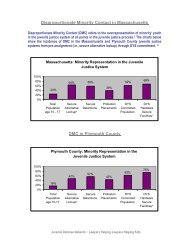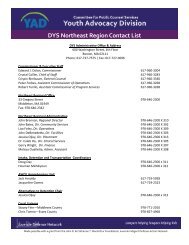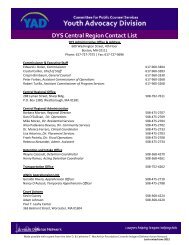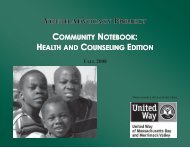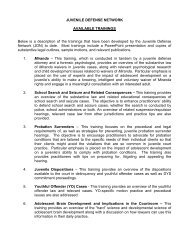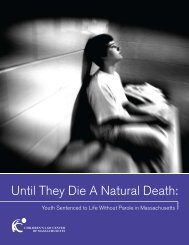States rethink 'adult time for adult crime' - the Youth Advocacy Division
States rethink 'adult time for adult crime' - the Youth Advocacy Division
States rethink 'adult time for adult crime' - the Youth Advocacy Division
Create successful ePaper yourself
Turn your PDF publications into a flip-book with our unique Google optimized e-Paper software.
subjects take longer to respond when <strong>the</strong>y’re asked to associate black faces with<br />
positive adjectives and white faces with negative adjectives than vice versa, and<br />
this is said to be an implicit measure of unconscious racism. Phelps and her<br />
colleagues added neurological evidence to this insight by scanning <strong>the</strong> brains and<br />
testing <strong>the</strong> startle reflexes of white undergraduates at Yale be<strong>for</strong>e <strong>the</strong>y took <strong>the</strong><br />
I.A.T. She found that <strong>the</strong> subjects who showed <strong>the</strong> most unconscious bias on <strong>the</strong><br />
I.A.T. also had <strong>the</strong> highest activation in <strong>the</strong>ir amygdalas — a center of threat<br />
perception — when unfamiliar black faces were flashed at <strong>the</strong>m in <strong>the</strong> scanner. By<br />
contrast, when subjects were shown pictures of familiar black and white figures<br />
— like Denzel Washington, Martin Lu<strong>the</strong>r King Jr. and Conan O’Brien — <strong>the</strong>re<br />
was no jump in amygdala activity.<br />
The legal implications of <strong>the</strong> new experiments involving bias and neuroscience<br />
are hotly disputed. Mahzarin R. Banaji, a psychology professor at Harvard who<br />
helped to pioneer <strong>the</strong> I.A.T., has argued that <strong>the</strong>re may be a big gap between <strong>the</strong><br />
concept of intentional bias embedded in law and <strong>the</strong> reality of unconscious<br />
racism revealed by science. When <strong>the</strong> gap is “substantial,” she and <strong>the</strong> U.C.L.A.<br />
law professor Jerry Kang have argued, “<strong>the</strong> law should be changed to comport<br />
with science” — relaxing, <strong>for</strong> example, <strong>the</strong> current focus on intentional<br />
discrimination and trying to root out unconscious bias in <strong>the</strong> workplace with<br />
“structural interventions,” which critics say may be tantamount to racial quotas.<br />
One legal scholar has cited Phelps’s work to argue <strong>for</strong> <strong>the</strong> elimination of<br />
peremptory challenges to prospective jurors — if most whites are unconsciously<br />
racist, <strong>the</strong> argument goes, <strong>the</strong>n any decision to strike a black juror must be<br />
infected with racism. Much to her displeasure, Phelps’s work has been cited by a<br />
journalist to suggest that a white cop who accidentally shot a black teenager on a<br />
Brooklyn rooftop in 2004 must have been responding to a hard-wired fear of<br />
unfamiliar black faces — a version of <strong>the</strong> amygdala made me do it.<br />
Phelps herself says it’s “crazy” to link her work to cops who shoot on <strong>the</strong> job and<br />
insists that it is too early to use her research in <strong>the</strong> courtroom. “Part of my<br />
discom<strong>for</strong>t is that we haven’t linked what we see in <strong>the</strong> amygdala or any o<strong>the</strong>r<br />
region of <strong>the</strong> brain with an activity outside <strong>the</strong> magnet that we would call racism,”<br />
she told me. “We have no evidence whatsoever that activity in <strong>the</strong> brain is more<br />
predictive of things we care about in <strong>the</strong> courtroom than <strong>the</strong> behaviors<br />
<strong>the</strong>mselves that we correlate with brain function.” In o<strong>the</strong>r words, just because





